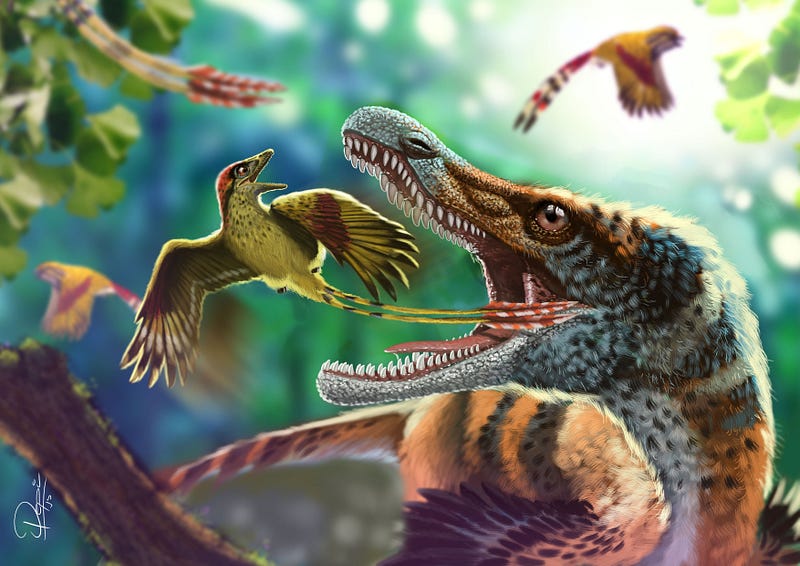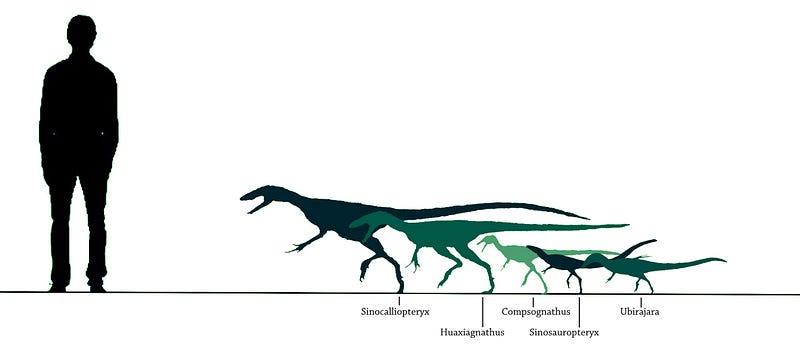Exploring Compsognathids: The Tiny Dinosaurs of the Mesozoic
Written on
Introduction to Compsognathids
Meet some of the tiniest dinosaurs that ever existed! The Mesozoic Quick Fact Series (MQFS) is designed to share intriguing insights about various extinct animal groups in an engaging and digestible manner. This article will offer a brief overview of the Compsognathidae, a family primarily made up of small theropod dinosaurs from the Jurassic and Cretaceous periods.
Let’s dive right in! To start with some foundational information…
The family was established by paleontologist Edward Drinker Cope in 1875, who named it after the type species, Compsognathus longipes, found in 1861. Compsognathids possess characteristics typical of theropods, including comparatively smaller forelimbs than their hind legs. Their notably petite stature, along with feathers and the size of their metacarpals, distinguishes them from other theropods.
Fossils of genera like Sinosauropteryx, Sinocalliopteryx, and Juravenator provide evidence of primitive feather coverings across much of their bodies, while Compsognathus also displays scales on its tail and hind legs.
When Did They Roam the Earth?
Compsognathids thrived between 151 and 108 million years ago. The earliest genera appeared during the Tithonian stage of the Late Jurassic, with the latest surviving until the Albian stage of the Early Cretaceous, spanning nearly 40 million years in the fossil record.
Where Were They Found?
Fossils of Compsognathids have been discovered in various locations, including Germany, France, Brazil, China, and possibly Argentina, Portugal, and the UK. These theropods successfully spread across three continents: Asia, Europe, and South America.

Size and Proportions
Compsognathids are recognized as some of the smallest dinosaurs to have existed. Compsognathus, once regarded as the tiniest dinosaur, reached lengths of approximately 1 meter (3 feet 3 inches) and weighed around 2.5 kg (5.5 lbs). Other genera within this family, such as Sinosauropteryx, Juravenator, and Ubirajara, exhibited similar sizes.
The largest known compsognathids include Sinocalliopteryx and Huaxiagnathus from China, with Sinocalliopteryx measuring about 2.4 meters (7 feet 10 inches) and Huaxiagnathus reaching lengths of up to 1.8 meters (5 feet 11 inches).

Noteworthy Names in Compsognathids
Several compsognathids have fascinating names worth mentioning, including Compsognathus, Sinosauropteryx, Mirischia, and Ubirajara. The family’s namesake, Compsognathus, translates to "elegant jaw" due to its delicate cranial bones. Sinosauropteryx, discovered in China, means "Chinese reptilian wing," highlighting its feathered appearance. Mirischia translates to "wonderful hip" in reference to its unique structure, while Ubirajara means "lord of the spear," alluding to its distinctive shoulder spikes.
Compsognathus in Popular Culture
Among dinosaurs, Compsognathus is one of the most recognized and has appeared in numerous documentaries, films, books, and video games. Featured in Michael Crichton's novel "Jurassic Park" (1990) and its sequel "The Lost World" (1995), Compsognathus was depicted as a scavenger that hunted in groups, attacking the weak or deceased.
Although it didn't appear in the original "Jurassic Park" (1993) film, it made a notable appearance in the sequel. Over the years, Compsognathus has been featured in various media related to the franchise, including "Jurassic World: Fallen Kingdom" (2018) and "Jurassic World: Dominion" (2022).
The first video showcases the thrilling scene where the Brazilian compsognathid Mirischia is seen chasing the enantiornithine bird Cratoavis, highlighting the dynamic interactions of these ancient creatures.
Did You Know?
- Compsognathus was the first dinosaur known from a relatively complete skeleton at the time of its discovery.
- Sinosauropteryx is recognized as the first non-avian dinosaur found with evidence of feathers and is one of the few for which scientists have determined coloration, revealing it likely had reddish-brown feathers with distinct patterns.

- Ubirajara, a remarkable compsognathid from Brazil, is noted for its unique integumentary structures resembling the display feathers of modern birds.
Further Reading
- Bizarre New Dinosaur Sported Mane & Shoulder ‘Spears’
- Who Said We Don’t Know The True Color of Dinosaurs?
References
Peyer, Karin. “A reconsideration of Compsognathus from the Upper Tithonian of Canjuers, southeastern France.” Journal of Vertebrate Paleontology 26.4 (2006): 879–896.
Sales, Marcos AF, Paulo Cascon, and Cesar L. Schultz. “Note on the paleobiogeography of Compsognathidae (Dinosauria: Theropoda) and its paleoecological implications.” Anais da Academia Brasileira de Ciências 86.1 (2014): 127–134.
Hwang, S.H.; Norell, M. A.; Qiang, J.; Keqin, G. (2004). “A large compsognathid from the Early Cretaceous Yixian Formation of China”. Journal of Systematic Palaeontology. 2: 13–39.
Chen, P.; Dong, Z.; Zhen, S. (1998). “An exceptionally well-preserved theropod dinosaur from the Yixian Formation of China”. Nature. 391 (6663): 147–152.
Wagner, J. A. (1859). “Über einige im lithographischen Schiefer neu aufgefundene Schildkröten und Saurier”. Gelehrte Anzeigen der Bayerischen Akademie der Wissenschaften. 49: 553.
The second video features a dramatic moment in which Littlefoot destroys a special tree, showcasing the emotional depth and narrative elements present in "The Land Before Time XI: Invasion of the Tinysauruses."